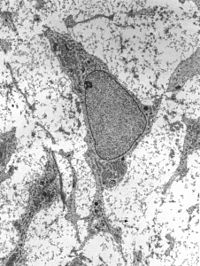
Photo from wikipedia
Stem cell transplantation in regenerative medicine has been widely used in various disorders including cardiovascular diseases (CVD) and emerging next-generation therapy. However, transplanted stem cell encountered ischemia/reperfusion (IR) injury which… Click to show full abstract
Stem cell transplantation in regenerative medicine has been widely used in various disorders including cardiovascular diseases (CVD) and emerging next-generation therapy. However, transplanted stem cell encountered ischemia/reperfusion (IR) injury which is a major challenge for stem cell survival. During the acute phase after myocardial infarction (MI) cytokine–rich hostile microenvironment, extensive immune cell infiltration and lack of oxygen have been a bottleneck in cell-based therapy. During prolonged ischemia, intracellular pH and ATP level decrease results in anaerobic metabolism and lactate accumulation. Consequentially, ATPase-dependent ion transport becomes dysfunctional, contributing to calcium overload and cell death by apoptosis and necrosis. Although O 2 level revitalizes upon reperfusion, a surge in the generation of reactive oxygen species (ROS) occurs with neutrophil infiltration in ischemic tissues further aggravating the injury. Ischemic preconditioning (IPC) of stem cells with a repeated short cycle of IR results in the release of chemical signals such as NO, ROS, and adenosine which triggers a cascade of signaling events that activates protein kinase C (PKC), Src protein tyrosine kinases, and nuclear factor κB (NF-κB) and subsequently increased synthesis of inducible NO synthase (iNOS), cyclooxygenase-2 (COX-2), Heme oxygenase-1 [HO-1], aldose reductase, Mn superoxide dismutase, and anti-apoptotic genes (Mcl-1, BCl-x L , c-FLIP L , c-FLIP S ). Pharmacological preconditioning uses a phosphodiestrase inhibitor, another mode of protecting stem cell or heart per se from impending ischemic injury in two phases. During the early phase of cardioprotection (2 h), PC leads to increased expression of survival factors like BCl 2 /Bax ratio while late phase (24 h) showed activation of the JAK/STAT survival pathway. Phosphorylation of STAT3 at two crucial residues, Tyr-705 and Ser-727, allows its entry inside the nucleus and upregulates the expression of protein kinase G-1 (PKG1) which evokes cardioprotective signaling. To confirm, heart-specific conditional STAT3 knockout mice undergone IR surgery, abolishing late-phase cardioprotective effects.
Journal Title: Heart Failure Reviews
Year Published: 2019
Link to full text (if available)
Share on Social Media: Sign Up to like & get
recommendations!